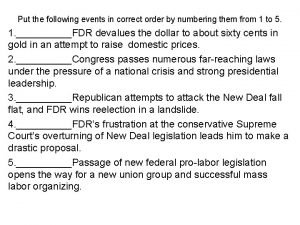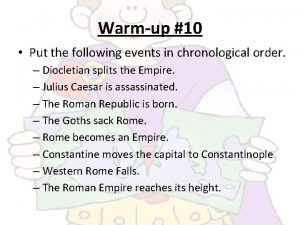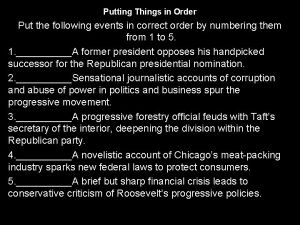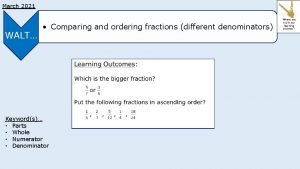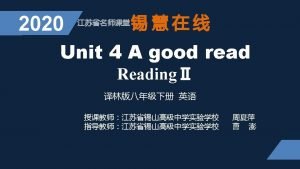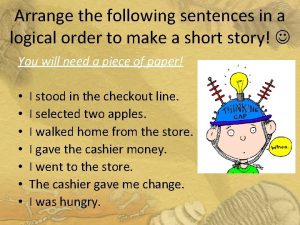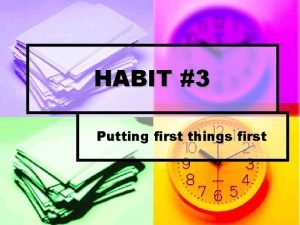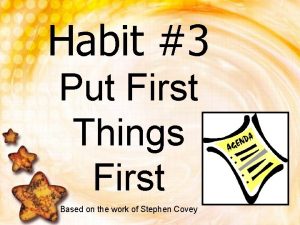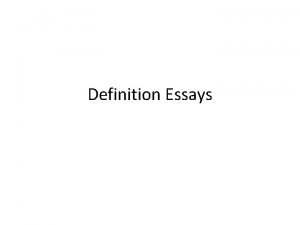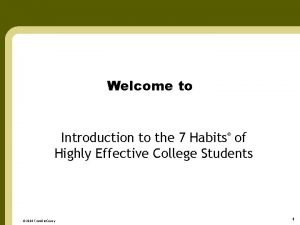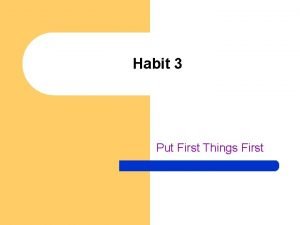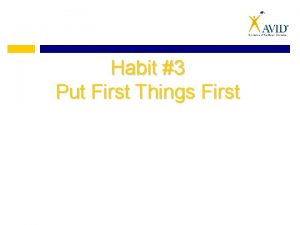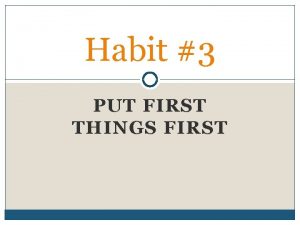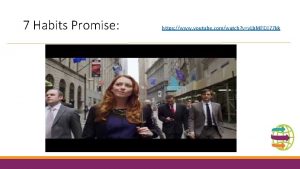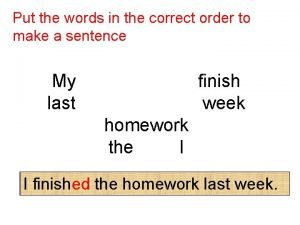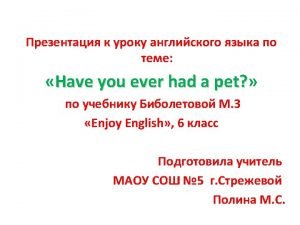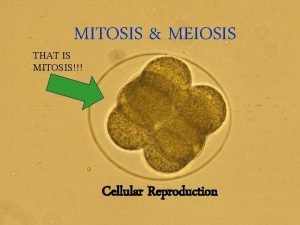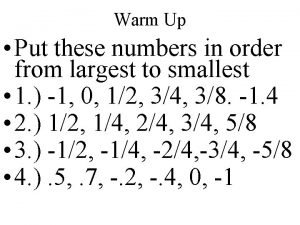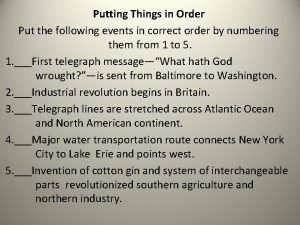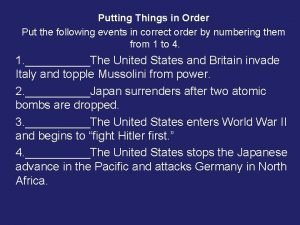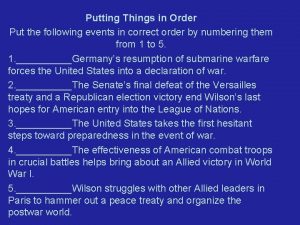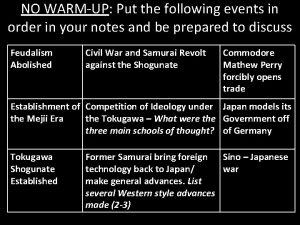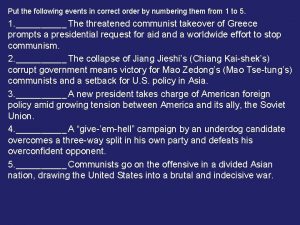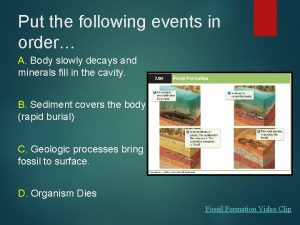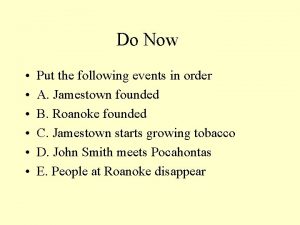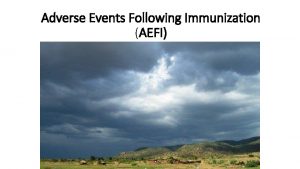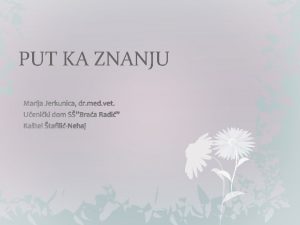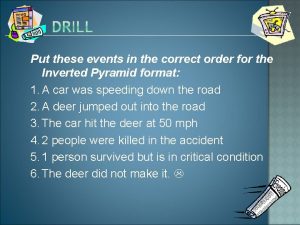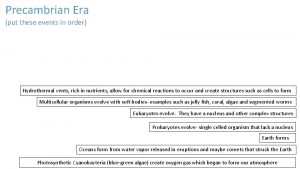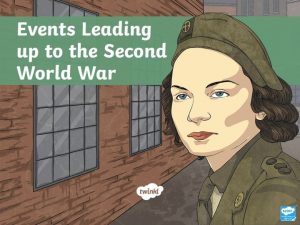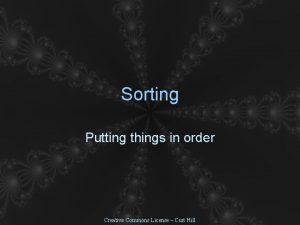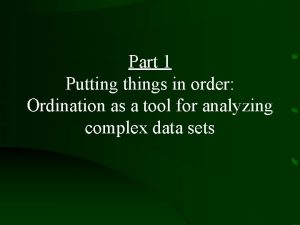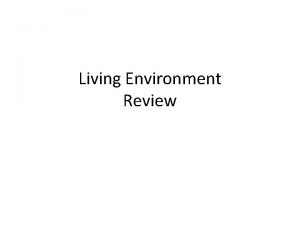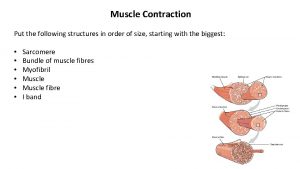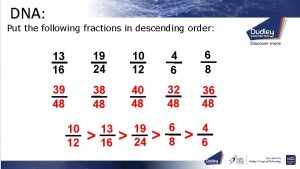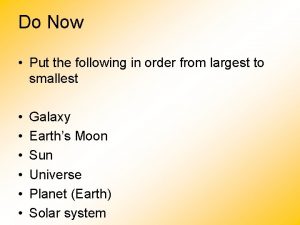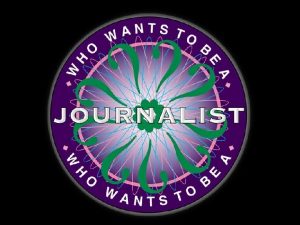Putting Things in Order Put the following events






























- Slides: 30

Putting Things in Order Put the following events in correct order by numbering them from 1 to 5. 1. _____A former president opposes his handpicked successor for the Republican presidential nomination. 2. _____Sensational journalistic accounts of corruption and abuse of power in politics and business spur the progressive movement. 3. _____A progressive forestry official feuds with Taft’s secretary of the interior, deepening the division within the Republican party. 4. _____A novelistic account of Chicago’s meat-packing industry sparks new federal laws to protect consumers. 5. _____A brief but sharp financial crisis leads to conservative criticism of Roosevelt’s progressive policies.

Teddy Roosevelt Progressive Reformer • • • President from 1901 to 1909 Once Assistant Secretary of Navy Served in Spanish American War – The Rough Riders – Battle of San Juan Hill • • Believed “every citizen in the US deserves fair treatment” resulting in “the government giving them a SQUARE DEAL” The President should set the legislative agenda for the government and for Congress

1902 -THE COAL MINERS STRIKE • UMWA WENT ON STRIKE WANTING: • • To be recognized by ownership Have some control over the industry • May 1902 - 150, 000 miners went on strike • The owners refused to negotiate with the miners • Oversupply had diminished coal prices Since most cost was related to payroll, higher prices meant greater profits • • There was no reason to negotiate as the owners kept getting richer!

• But, it was illegal for the coal mines to shut down by owners • Roosevelt forced the owners back to the table to negotiate by threatening to take over their mines using the army • To mediate, he creates the Anthracite Coal Commission Result: *10% wage increase *A nine hour work day *Create a labor control board to arbitrate disputes Significance: The federal government stepped in to help the people!!!! be

Identification Supply the correct identification for each numbered description. 1. _____A largely middle-class movement that aimed to use the power of government to correct the economic and social problems of industrialism 2. _____Popular journalists who used publicity to expose corruption and attack abuses of power in business and government 3. _____Progressive proposal to allow voters to bypass state legislatures and propose legislation themselves 4. _____Progressive device that would enable voters to remove corrupt or ineffective officials from office 5. _____Roosevelt’s policy of having the federal government promote the public interest by dealing evenhandedly with both labor and business

• Elected in 1904. Roosevelt became the Trust Buster! “Trusts that harm and stifle competition are bad and should be broken up, but trusts that run efficiently and have low prices are good” He busted over 40 trusts during his administration including: National Securities (RR’s), Standard Oil and Duke’s Tobacco trust Roosevelt also focused on protecting the people through the power of the government.

Consumer protection laws: • Elkins Act - prevented railroad rebates to favored customers • Hepburn Act - government could set just and reasonable rates - access to financial records for taxation • The Meat Inspection Act - Federal inspectors were allowed to inspect meat processing facilities at any time • Pure Food And Drug Act - manufacture and sale of impure drugs is forbidden - products must be tested to prove a “cure” occurs - items labeled with ingredients

Roosevelt the Conservationist Before becoming President, Roosevelt watched how industrialization and mechanical progress was decimating America’s wildlife and natural resources He believed in government intervention to protect our nation for future generations He established : - 51 Bird Reserves, - 4 Game Preserves - 150 National Forests. - signed into law the creation of 5 National Parks - proclaimed 18 national monuments - placed under public protection approximately 230, 000 acres

Legislation: Forest Reserve Act set aside land as natural reserves not to be sold Newlands Reclamation Act Money from sale of public lands was used for irrigation projects in the west Antiquities Act Allowed President to create national monuments by proclamation, without congressional approval

Tired of the presidency, Roosevelt endorsed… William Howard Taft He won by a landslide!!!! The only president to get stuck in a bathtub!

During his administration (1909 - 1913) he busted 99 trusts! and one bathtub Legislation: • Mans - Elkins Act : ICC can suspend RR rates and oversee communications companies • 16 th Amendment : Authorizes the government to collect an income tax (on the very rich only) But his desire to protect America will cause his downfall The Payne Adlrich Act!

The Payne - Aldrich Act Payne’s bill called for a reduction in tariffs and was passed in the congress. Aldrich’s bill called for the opposite and raised tariffs A compromised bill was reached, but it raised tariffs on all imports to a prohibitive amount. Taft immediately signed the bill betraying the ideals of the Progressive party “This is the best bill put forth by the Republicans in many years”

Taft then fired Gifford Pinchot -Chief of the Forestry Service (and was appointed by Roosevelt personally) For speaking out against Richard Ballinger’s leasing of protected Alaskan woodlands These and other acts split the Republican Party and led to the return of…… Teddy Roosevelt And the establishment of The Bull Moose Party The Progressives in disguise

6. _____Effective railroad-regulation law of 1906 that greatly strengthened the Interstate Commerce Commission 7. _____Disastrous industrial fire of 1911 that spurred workmen’s compensation laws and some state regulation of wages and hours in New York 8. _____Upton Sinclair’s novel that inspired proconsumer federal laws regulating meat, food, and drugs 9. _____Powerful women’s reform organization led by Frances Willard

10. _____Brief but sharp economic downturn of 1907, blamed by conservatives on the supposedly dangerous president 11. _____Generally unsuccessful Taft foreign policy in which government attempted to encourage overseas business ventures 12. _____Powerful corporation broken up by a Taft-initiated antitrust suit in 1911

Often a broad historical movement, such as progressivism, can best be understood by breaking it down into various component parts. Among the varieties of progressive reform discussed in this chapter are (A) political progressivism (B) economic or industrial progressivism (C) consumer progressivism (D) environmental progressivism 1. _____ The Newlands Act of 1902 2. _____ The ten-hour law for bakers 3. _____ The movement for women’s suffrage 4. _____ The anthracite coal strike of 1902 5. _____ Direct election of senators 6. _____ The Meat Inspection Act of 1906 7. _____ The Pure Food and Drug Act 8. _____ Initiative, referendum, and recall 9. _____ Muller v. Oregon 10. _____ The Hepburn Act of 1906 11. _____ Yosemite and Grand Canyon National Parks 12. _____ Workmen’s compensation laws

1. What caused the Taft-Roosevelt split, and how did it reflect the growing division between Old Guard and progressive Republicans? 2. The two key goals of progressivism, according to the text, were to use the government to curb monopolistic corporations and to enhance the ordinary citizen’s welfare. How successful was it in attaining these two goals?

• Put Chapter 29 Put the following events in correct order by numbering them from 1 to 5. 1. _____Wilson extracts a dangerously conditional German agreement to halt submarine warfare. 2. _____Wilson’s superb leadership pushes major reforms of the tariff and monetary system through Congress. 3. _____The bull moose and the elephant are both electorally defeated by a donkey bearing the banner of “New Freedom. ” 4. _____The heavy loss of American lives to German submarines nearly leads the United States into war with Germany. 5. _____Despite efforts to avoid involvement in the Mexican revolution, Wilson’s occupation of a Mexican port raises the threat of war.

Cause 1. ___ Old-time Populists, muckraking journalists, social-gospel ministers, and European socialist immigrants 2. ___Progressive concern about political corruption 3. ___ Governors like Robert La Follette 4. ___Roosevelt’s threat to seize the anthracite coal mines 5. ___Settlement houses and women’s clubs 6. ___Upton Sinclair’s The Jungle 7. ___Roosevelt’s personal interest in conservation 8. ___Taft’s political mishandling of tariff and conservation policies 9. ___Russia’s and Japan’s hostility to an American role in China 10. ___Roosevelt’s feeling that he was cheated out of the Republican Effect a. Ended the era of uncontrolled exploitation of nature and involved the federal government in preserving natural resources b. Led to reforms like the initiative, referendum, and direct election of senators c. Forced a compromise settlement of a strike that threatened the national wellbeing d. Outraged consumers and led to the Meat Inspection Act and the Pure Food and Drug Act e. Laid the basis for a third-party crusade in the election of 1912 f. Incensed pro-Roosevelt progressives and increased their attacks on the Republican Old Guard g. Led the way in using universities and regulatory agencies to pursue progressive goals h. Made Taft’s dollar-diplomacy policy a failure i. Provided the pioneering forces who

Roosevelt headed a third party Progressive Republican Party - more business regulation - women’s suffrage - more social welfare programs Taft was re-elected to the Republican ballot The Democrats nominated NJ governor Woodrow Wilson He also stood on progressive ideas and his unified party sailed him to a victory in the Presidential election of 1912

Woodrow Wilson is the first democratic president since the Civil War! He believed: - The President should lead the nation - He promised to break the Triple Wall of Privilege: -tariffs -banking -trusts When necessary, appeal to the people to make things happen

President Wilson’s reforms: Underwood Tariff Act - lowered tariffs for the first time in 50 years (He did raise the income tax to 6% to compensate) Clayton Antitrust Act - exempted unions from being prosecuted as trusts Federal Farm Loan Act - 12 farming banks were created to give farmers loans with low interest rates Warehouse Act Loans based on growth of staple crops - basic crops (corn, wheat) Child Labor Act -stopped shipment of products made by children under 14 over state lines -Hammer v. Dagenhart

New Freedom! The consolidation of Wilson’s reform ideas became known as New Freedom Louis Brandeis – Other People’s Money - large banks were colluding with businessmen to create trusts - trusts stifle competition - became so large that they became unable to operate efficiently.

The Federal Reserve Act - Create a new centralized bank the US for - owned and operated by government the - out of control of the "money trust", ending Wall Street's control of American currency supply

• both private and public entities can be members • 12 private regional Federal reserve banks each with its own branches, board of directors and district boundaries • headed by a seven member Federal Reserve Board ( public officials appointed by the President) • a single new United States currency, the Federal Reserve note • nationally chartered banks must become members of the Federal Reserve System. • required to purchase non-transferable stock in their regional reserve bank • must set aside a stipulated amount of non-interest bearing reserves • member banks have access to discounted loans • Federal reserve banks act as fiscal agents for the United States government (loan it money).

But Wilson’s greatest foe was just around the corner…. By the end of 1914 World War I would plunge the world into a global conflict. And President Wilson will try his best to keep us out of the war. But can he……. .

1. _____Four-footed symbol of Roosevelt’s Progressive third party in 1912 2. _____A fourth political party, led by a former railroad labor union leader, that garnered nearly a million votes in 1912 3. _____Wilson’s political philosophy of restoring democracy through trust-busting and economic competition 4. _____A twelve-member agency appointed by the president to oversee the banking system under a new federal law of 1913 5. _____New presidentially appointed regulatory commission designed to prohibit unfair business competition, unethical advertising, and labeling practices

6. _____Wilsonian trust-busting law that prohibited interlocking directorates and other monopolistic business practices, while legalizing labor and agricultural organizations 7. _____Wilson-backed law that promised the Philippines eventual independence from the United States, but only when a stable and secure government was attained 8. _____Troubled Caribbean island nation where a president’s murder led Wilson to send in the marines and assume American control of the police and finances 9. _____Term for the three Latin American nations whose mediation prevented war between the United States and Mexico in 1914 10. _____World War I alliance headed by Germany and Austria-Hungary

Constructing a Historical Argument Prompt: Compare and contrast the progressivism of Roosevelt with that of Wilson; identify which politician had the best answer to solving the major issues during the Progressive era. Roosevelt Write a Thesis for the above Prompt Wilson

1. What were the results of Wilson’s great reform assault on the “triple wall of privilege”—the tariff, the banks, and the trusts? 2. In what ways was Wilson the most pro-labor president up to that point in American history? Which specific laws, policies, and appointments reflect his support for ordinary workers? 3. How was Wilson’s foreign policy an attempt to expand idealistic progressive principles from the domestic to the international arena? Why did Wilson’s progressive democratic idealism lead to the very kind of U. S. interventions in other countries that he professed to dislike?
 Put the events of the last act in the correct order.
Put the events of the last act in the correct order. Put the following events in chronological order.
Put the following events in chronological order. To put things in order
To put things in order Putting things together is called
Putting things together is called The order of putting on ppe
The order of putting on ppe Ordering fractions
Ordering fractions Arrange sentence in correct order
Arrange sentence in correct order Photo
Photo Put the following letters to their correct order
Put the following letters to their correct order Arrange the following sentence.
Arrange the following sentence. 1st order 2nd order 3rd order neurons
1st order 2nd order 3rd order neurons Put out the light then put out the light
Put out the light then put out the light You put your right foot in you put your right foot out
You put your right foot in you put your right foot out Mutually exclusive events vs not mutually exclusive events
Mutually exclusive events vs not mutually exclusive events Sharpen the saw examples
Sharpen the saw examples Habit 3 lesson plans
Habit 3 lesson plans Habit 3 first things first
Habit 3 first things first Put first things first definition
Put first things first definition See do get model
See do get model Habit 3 put first things first
Habit 3 put first things first Put first things first video
Put first things first video Habit 3 activities
Habit 3 activities 7 habits promise
7 habits promise Things fall apart summary chapter 18
Things fall apart summary chapter 18 Use yet in a sentence
Use yet in a sentence Put these words in order
Put these words in order Put the letter in the right order
Put the letter in the right order Put these in order
Put these in order Put these in order
Put these in order Put these decimals in order starting with the smallest
Put these decimals in order starting with the smallest Put these numbers in order
Put these numbers in order
